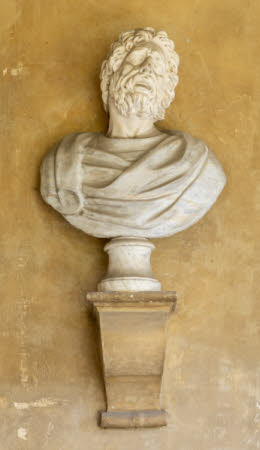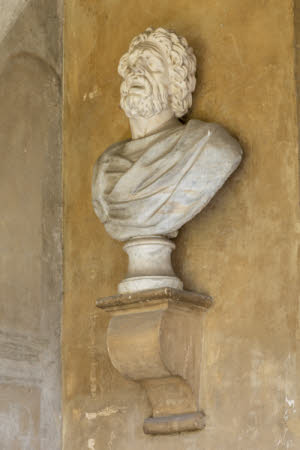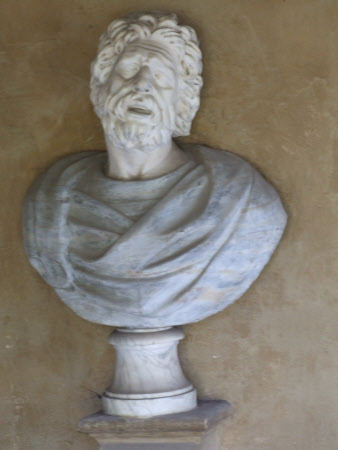Bust of the Trojan priest Laocöon.
Category
Art / Sculpture
Date
c. 1650 - 1670
Materials
Marble
Order this imageCollection
Ham House, Surrey
NT 1140382
Summary
A marble bust of the Trojan priest Laocoön, derived from the marble sculptural group of Laocoön and his sons in the Vatican Museums in Rome. Laocoön turns his head to his left and cries out in grief and pain. Possibly one a group of marble busts installed on the Great Staircase of Ham House in the 1670s.
Full description
A marble bust of the Trojan priest Laocoön, derived from the marble sculptural group of Laocoön and his sons now in the Vatican Museums in Rome. Laocoön, bearded and with thick and vigorously curled hair, turns his head to his left, crying out in grief and pain. The bust section with its loose robes appears to be in grey marble, now over-painted, as is the turned marble socle. The bust is derived from the celebrated antique group in the Vatican, depicting the Trojan priest Laocöon and his two sons struggling in agony, as they are overwhelmed by hideous serpents. Ever since its discovery in 1506, the Laocöon has remained one of the most constantly admired of all Classical antiquities. Laocöon was a priest of the city of Troy and the only person in the city to distrust the wooden horse left behind by the Greek armies, before they appeared to lift their siege of Troy in order to return to Greece. Uttering the celebrated words ‘I still fear Greeks, even when they offer gifts’, Laocöon even thrust a spear into the side of the wooden horse, thus inciting the anger of the goddess Minerva. She exacted her revenge when Laocöon was sacrificing a bull at the altar of his cult-god Neptune. Suddenly two giant sea-snakes came tearing through the water and pounced on the two sons and then the father, suffocating them and tearing them apart. The Laocoön caused a sensation when it was rediscovered during excavations in Rome in January 1506. Subsequently full-size copies and reductions were made in marble and in bronze, as well as portrait busts based on Laocoön and, less frequently, his two sons. The hair in the Ham House bust is a little more restrained than the furiously tumbling locks in the original Laocoön, but the tilt of the head and the open mouth help to confirm it as a portrait of the Trojan priest. It is one of four marble busts in the Classical style (NT 1140382-385), now set on stone consoles high up in the portico of Ham House. They may well be identifiable with the ‘4 Marble heads’ recorded as displayed on the Great Staircase in the 1677 inventory of Ham House. These seem to have been installed on the Staircase in 1671/72, when the bricklayer John Burnell was paid for the ‘cutting of holes in ye staircase for ye heads to stand in, & helping them up’ (Charles Avery, ‘Seventeenth-Century Sculpture at Ham House’ in Christopher Rowell, ed., Ham House. 400 Years of Collecting and Patronage, New Haven/London 2013, pp. 158-77, p. 169). The staircase was altered and the wall niches filled in in the nineteenth century, when the busts may have been reinstalled in the portico. However, another inventory of Ham House compiled in 1679 recorded 'Six Marble heads' in the 'Cloisters and Fore-court', i.e. the portico and forecourt area, so it is also possible that these included the four busts, which would in this event have remained in much the same position since the seventeenth century. Although the four marble busts may have been made in Rome and imported to England, it is more probable that they were made locally in London. Jeremy Warren December 2021
Provenance
Elizabeth Murray and John Maitland, 1st Duke and Duchess of Lauderdale. Possibly installed on the Great Staircase of Ham House in 1671/72, and moved to their present position some time in the nineteeth century. Thence by descent, until acquired in 1948 by HM Government when Sir Lyonel, 4th Bt (1854 – 1952) and Sir Cecil Tollemache, 5th Bt (1886 – 1969) presented Ham House to the National Trust. Entrusted to the care of the Victoria & Albert Museum until 1990, when returned to the care of the National Trust, to which ownership was transferred in 2002.
References
Avery 2013: Charles Avery, ‘Seventeenth-century Sculpture at Ham House’ in Christopher Rowell, ed., Ham House. 400 Years of History, New Haven/London 2013, pp. 158-77., p. 169.


